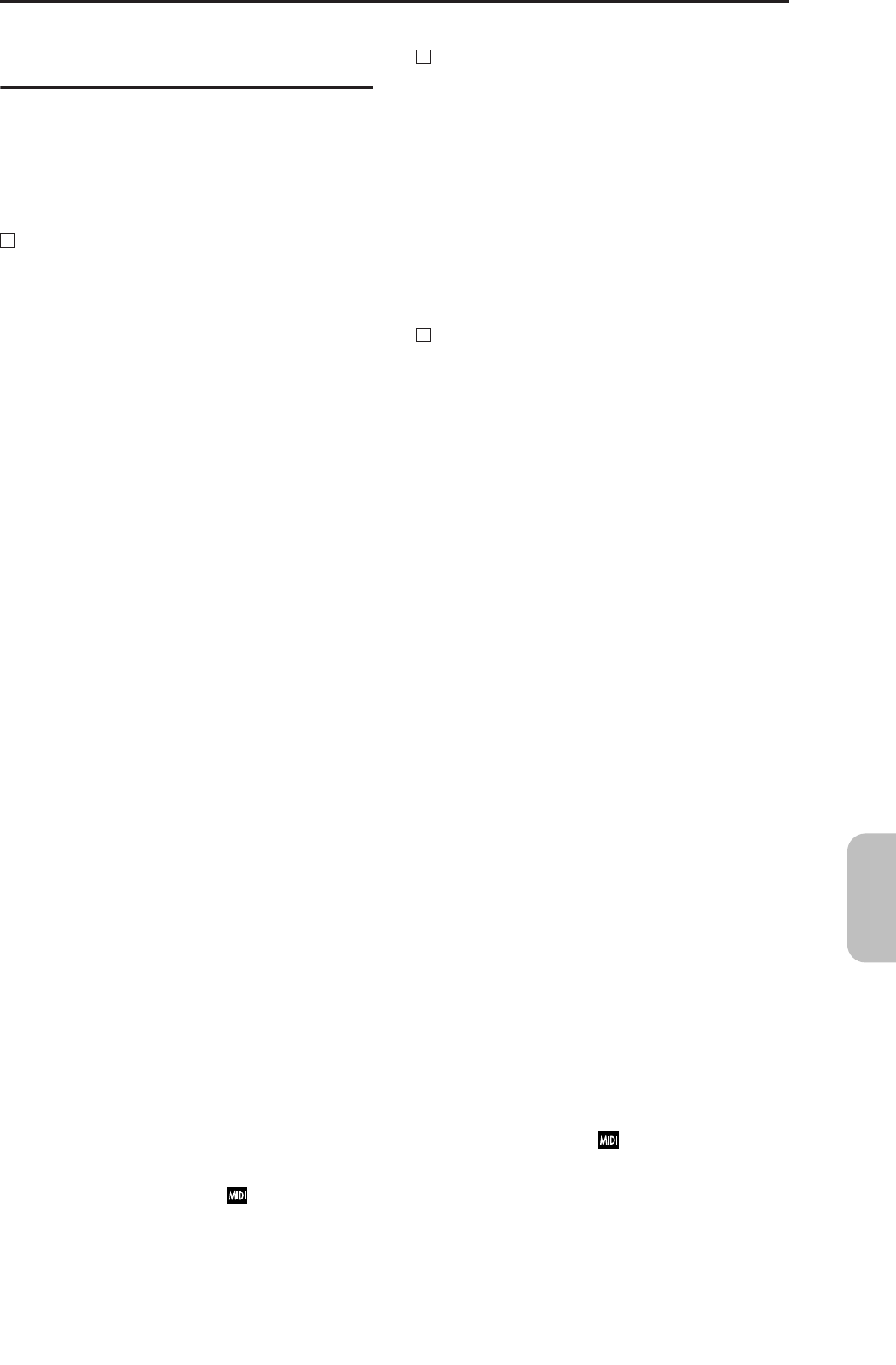
171
Appendices
MIDI applications
■ Messages transmitted and
received by this instrument
[...] indicates hexadecimal notation
MIDI channels
MIDI messages can be exchanged when the transmitting
and receiving devices are set to the same MIDI channel.
MIDI uses sixteen channels, numbered 1–16. The way in
which channels are handled will differ depending on the
mode.
Program mode
• Transmission/reception is performed on the global
MIDI channel*.
* The global MIDI channel is the basic channel that this
instrument uses for MIDI transmission/reception, and
is set by “MIDI Channel” (GLOBAL 1–1a).
Combination mode
• The global MIDI channel is used to transmit/receive
messages for selecting a combination and turning effects
on/off, and to transmit/receive exclusive data.
• The MIDI channel specified for each timbre (in COMBI
2–1a) is used to transmit/receive MIDI data for each
timbre.
• The MIDI channel specified for the insert effect and
master effects (in MIDI channel “Control Ch (control
Channel)” (COMBI 8–2b)) is used to control dynamic
modulation, and to control the pan and send 1/2 after
the sound has passed through the insert effects.
• When you operate the keyboard or controllers of the
X50/microX, messages will be transmitted on the global
MIDI channel, and will also be transmitted on the MIDI
channel of any timbre whose “Status” (COMBI 2–1a) is
set to EXT or EX2.
• Channel messages will be received if they match the
MIDI channel of a timbre whose “Status” is set to INT
(☞p.40 “Status” and “MIDI Channel”).
Multi mode
• The global MIDI channel is used to transmit/receive
exclusive data and for messages that switch effects on/
off.
• MIDI data of each track is transmitted/received on the
MIDI channel specified for each track (In Multi mode,
this will be the settings of MULTI 2–1(2)a.)
• The MIDI channel specified for the insert effect and
master effects (in MULTI 8–3b) is used to control
dynamic modulation, and to control the pan and send 1/
2 after the sound has passed through the insert effect.
• When you operate the keyboard or controllers of the
X50/microX, messages will be transmitted on the MIDI
channel selected by “Control Track” (MULTI 0–1a).
However, messages will be transmitted only if the track
selected by “Control Track” has a “Status” of BTH, EXT,
or EX2. ( ☞p.56 “Control Track”– )
•Tracks whose “Status” is INT or BTH will receive
channel messages of the matching MIDI channel (☞p.61
“Status” and “MIDI Channel”).
Note on/off
Note-on [9n, kk, vv]
Note-off [8n, kk, vv]
(n: channel, kk: note number, vv: velocity)
When you play a note on the X50/microX’s keyboard, it will
transmit note-on/off messages. When the arpeggiator is
running, note-on/off messages will be transmitted by the
arpeggiator. (If Local Control is off, the arpeggiator will not
transmit note-on/off data. ☞OG p.32 “Local Control On set-
tings”)
Most devices do not transmit or receive note-off velocity,
and the X50/microX does not transmit or receive this data
either.
Program Change/Bank Select
Changing the program/bank
Program change [Cn, pp]
(n: channel, pp: program number that allows 128 sounds to
be selected)
• Programs 000–127 in banks (X50: A–D, microX: A–E)
correspond to program changes [Cn, 00]–[Cn, 7F].
• Programs 001–128 in banks G and g(d) correspond to
program changes [Cn, 00]–[Cn, 7F].
Bank select MSB (CC#0) [Bn, 00, mm],
Bank select LSB (CC#32) [Bn, 20, bb]
(n: channel, mm: bank number upper byte, bb: bank number
lower byte)
• The internal banks that correspond to each bank select
number will depend on the “Bank Map” setting
(GLOBAL 0–2a). With the factory settings, this will be
GM. (☞p.78 “Bank Map”)
Simply receiving a Bank Select message will not cause
the program or bank to change. The program or bank
will actually change when a Program Change message is
received.
Program mode
• In PROG 0: Play, program change and bank select
messages are transmitted and received on the global
MIDI channel. These messages are not received in PROG
1: Ed–Basic – PROG 9: Ed–MasterFX.
Combination, Multi mode
• Program change and bank select messages can be
received on the MIDI channel specified for each timbre/
track to select programs on that timbre/track.
• When you select a combination, program change and
bank select messages will be transmitted by timbres
whose “Status” is EXT or EX2.
In Multi mode when you change the “Program Select”
(MULTI 0–2(3)a) setting or reselect a multi set (“Multi
Mode” (GLOBAL 0–2a) set to “for Master”), program
change and bank select messages are transmitted on
tracks whose “Status” is set to BTH, EXT, or EX2.
(☞p.57 “Program Select”– )
• In Combination and Multi modes, transmission/
reception can be switched on/off for each timbre/track.
(☞p.42, 64 “Program Change”).


















